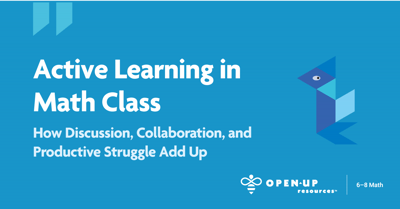 The conversations we have with educators regularly knock our socks off, and this interview with David Parascand was no exception. David not only helped create the Open Up Resources 6–8 Math curriculum, he also participated in the beta pilot of the materials and is a Secondary Math Specialist in Tumwater School District.
The conversations we have with educators regularly knock our socks off, and this interview with David Parascand was no exception. David not only helped create the Open Up Resources 6–8 Math curriculum, he also participated in the beta pilot of the materials and is a Secondary Math Specialist in Tumwater School District.
We sat down with David and discussed the challenges of utilizing a curriculum that promotes active learning in the math classroom – and what success looks like.
Q: How have you seen the Open Up Resources 6–8 Math curriculum change the experience for both students and teachers in the classroom?
A: The biggest shift I’ve seen is how the materials incorporate both instructional and language routines. The routines make the teacher’s expectations for kids explicit, and as a result, students are willing to be much more active participants in their learning. Students are having real discussion using academic language and making sense of each others ideas; it is a true mathematical community in their classrooms.
Q: How would you describe what your classrooms looked and felt like before this curriculum, and how would you describe them now?
A: The biggest difference we have seen is in how teachers understand student thinking. In the past, teachers would be surprised when kids didn’t do well on assessments, but now teachers see visible student thinking every day. Instead of being surprised come assessment time, teachers are able to evaluate student thinking daily and adjust instruction accordingly.
It has also completely changed the way we look at scaffolding. In the past we scaffolded how to do a problem. Now we are scaffolding how to think about the ideas. Teachers are showing multiple entry points to understanding the ideas and not just steps to solving a problem. A great example of this is with the concept of ratios. There are multiple ways to think about and solve problems with ratios. Teachers are able to expose students to more ways to think about ratios, both concrete and abstract, and then students have the choice to gravitate to the thinking method of their choice.
Q: Have you seen any success stories of struggling schools or students improving?
A: We have seen a lot of improvement for struggling students using this curriculum. One teacher in a struggling school saw a 20% increase in proficiency which is a huge leap. There were so many individual students that moved from a Level 1 to a Level 2, which means they went from well below grade level standards to just below or approaching standard. We know that, with more time with the curriculum, they will catch up to grade level.
Q: How are students handling working together so much?
A: It has been fascinating to watch the student relationships develop. We normally don’t see this sort of collaboration and group work until the end of the year, but with this curriculum the students are talking about math day in and day out, so they become comfortable much earlier. They are really exercising their mental muscles.
Q: Has it been difficult for teachers to truly use student thinking to guide instruction?
A: I won’t lie: sometimes it can be a little messy or loosey-goosey when you are trying to get to the main takeaway of the lesson…but you want the kids to be messy. The question the teacher has to answer is, “What can I do with the mess?” The lesson synthesis makes it clear what the end goal is and helps provide a laser focus so that the teacher can help the kids come to the right conclusions. The provided questions really help make sure teachers are steering the conversation in the right way, so that all students can have their “aha!” moment.
Q: Has it been hard for students to persevere through the productive struggle?
A: I have always thought that kids struggle when they don’t know what they’re working towards, but that isn’t the case here. Open Up Resources 6–8 Math gives students really explicit goals to work towards so that they really are productive with their struggle. That is a total difference-maker.

